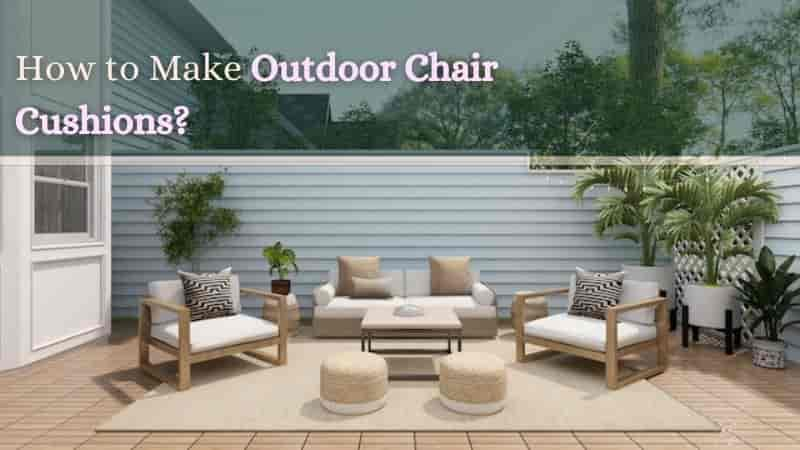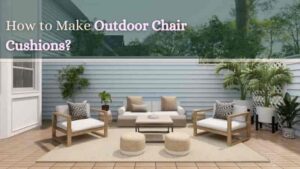Imagine enjoying a beautiful sunset on your patio, a refreshing drink in hand, yet something is lacking. Your outdoor furniture is lovely, but those hard seats make it tough to truly relax. You’ve looked at outdoor cushions in stores, but they’re never quite the right fit or style. You realize that learning how to make outdoor chair cushions might be the perfect solution! You can choose your favorite fabrics and the perfect foam fit and add little touches like rounded corners or decorative buttons. Crafting your cushions ensures they’re just right for your space. So, let’s dive into creativity; here are the steps to transform your outdoor living space!
Contents
- 1 A Step by Step Guide on How to Make Outdoor Chair Cushions
- 2 1: Measure and Plan
- 3 2: Cut the Fabric and Foam
- 4 3: Sew the Cushion Covers
- 5 4: Assemble the Cushion
- 6 5: Add Optional Features
- 7 6: Finish and Waterproof the Cushions
- 8 7: Place the Cushions and Enjoy
- 9 Conclusion
- 10 Frequently Asked Questions (FAQs)
A Step by Step Guide on How to Make Outdoor Chair Cushions

1: Measure and Plan
Measure Your Chair Seat
When it comes to creating the ideal outdoor cushions, the first step is to take accurate measurements. Using a special tape measure, assess the height, width, and depth measurement of the chair seat. This step helps you determine the fabric dimensions and the size of foam you need.
Choose Your Fabric and Foam
Your choice of materials plays a significant role in how to make outdoor chair cushions. Visit fabric stores and explore the beautiful fabrics they offer. Look for durable fabric like heavy-weight fabric, as these can withstand outdoor conditions. For foam options, a 4-inch thick foam or a 5-inch foam seat can provide the right comfort. If you like to read outside, use this advice to identify the best outdoor reading chair that will go well with your own cushions.
Plan for Extras
When cutting fabric, it’s crucial to consider seam allowances and extra inches for unexpected errors. Plan for rounded or curved corners to add a unique touch to your cushions. This planning phase ensures that finished cushion covers will fit the outdoor cushion covers.
2: Cut the Fabric and Foam
Cut the Fabric
Once you’ve selected the fabric for chair cushions, it’s time to cut the pieces. Cut the fabric to the exact dimensions with sharp scissors or a rotary cutter, considering an inch for seam allowance or a ½ inch seam allowance, depending on your preference.
Cut the Foam
Cutting foam requires different tools. Using a box cutter, utilize a roll of foam and cut them to the desired size. Whether it’s a piece of foam, inch foam, or foam panels, ensure it aligns with your fabric cutout. For those interested in building their own chairs, here’s a guide on building a living room chair that is a perfect companion to your cushion project.
3: Sew the Cushion Covers
Prepare the Fabric Pieces
The first step in sewing is to prepare your fabric pieces. Pin the fabric with sewing pins, ensuring the fabric is taut and aligned. This will aid in sewing straight stitches and prevent any excess fabric from bunching up. You may also use safety pins for extra hold.
Sew the Seams
With your fabric prepared, it’s time to sew the seams. Using your sewing machine with a zipper foot and a regular presser foot, carefully sew the fabric pieces. If you are a beginner, you may even want to test your settings on scrap fabric first.
Add Details
Attention to detail is what sets homemade items apart. Consider using a zig-zag stitch for a beautiful corner finish for added durability. You might also want to experiment with panel-from-seam designs for a professional touch. These techniques add to the aesthetic appeal of your outdoor furniture cushions.
4: Assemble the Cushion
Insert the Foam
Once your cushion cover is stitched, it’s time to make the foam fit inside the cushion cover. Upholstery foam or specific pieces of foam like 1-inch thick foam works best for this purpose. Ensure the foam piece aligns with the actual cover dimensions so the cushions feel comfortable. If you’re considering upgrading your entire patio, look at this guide on the most comfortable outdoor chair for more ideas.
Finalize the Seams
Finalizing your cushion involves closing the opening with care. You can choose between a blind stitch, a machine stitch, and a whip stitch, depending on your preference. If you want to be extra creative, you might even use covered buttons or flat buttons for a decorative touch.
5: Add Optional Features
Create Envelope Cushion Covers or Pillow Covers
Adding optional features gives your cushions a touch of uniqueness. For those who love a varied appearance, creating envelope cushion covers or pillow covers can be an exciting addition. Follow a sewing tutorial or a detailed video guide to master these specific styles. Using different fabric combos or recycled canvas fabric can create fascinating textures that will surely impress your guests.
Add Buttons
Another delightful feature you can incorporate is adding covered buttons or flat buttons. Whether you’re aiming for a rustic look or a modern twist, buttons can provide that extra touch. Threaded needles and special thread choices can make this process smoother, and nylon thread can give added strength.
6: Finish and Waterproof the Cushions
Inspect and Trim
Quality control is essential in DIY projects. Check for excess fabric and trim if needed using sharp fabric scissors. It’s not just about how the cushion looks but also about the feel. Your favorite fabrics should feel smooth to the touch without any annoying fabric corners or taut sections.
Waterproof the Cushions
To ensure your cushions are suitable for the outdoor living space, apply a waterproofing spray. Depending on the type of fabric, a fabric conversion calculator might be helpful in determining how much spray you’ll need. This step ensures that your beautiful fabrics stay vibrant and fresh, even in the open air.
7: Place the Cushions and Enjoy
Set the Cushions
Your DIY patio cushions are now ready! Place them on patio chairs, outdoor furniture, or even include them as replacement cushion options for worn-out originals. Their presence will make outdoor furniture cushions a lively part of your décor.
Relax and Enjoy
Finally, take a moment to revel in the comfort of your comfy cushions. After all your hard work, it’s time to relax and have fun. If you prefer, post a comprehensive comment or a video of the procedure.
Conclusion
In this comprehensive guide on how to make outdoor chair cushions, we’ve walked through the essentials, from measurement and planning to cutting the fabric, sewing cushion covers, assembling the cushion, adding optional features, waterproofing, and finally placing and enjoying your creations. These DIY cushions offer a beautiful way to revamp your outdoor living space. With the right fabric, a sewing machine, some creativity, and your personal touch, you can transform your patio furniture into a vibrant and comfy retreat. So, grab your fabric scissors, and let’s start crafting.
Frequently Asked Questions (FAQs)
What type of fabric is best for outdoor cushions?
The best fabric for outdoor cushions should be weather-resistant. Choices might include materials like Sunbrella, polyester blends with UV protection or marine vinyl. Consider factors like water resistance, UV stability, and color choices to suit your preferences and needs.
How do I properly measure my outdoor chairs for cushions?
Proper measurements are crucial for a perfect fit. Measure the length, width, and depth of the seating area, considering any curves or unique shapes. Creating a paper template by tracing the chair can also help in achieving an exact fit. Always double-check your measurements for accuracy.
Can I create outdoor chair cushions without a sewing machine?
Yes, outdoor chair cushions can be made without a sewing machine. Hand sewing is an alternative, although it can be more time-consuming. Other options include using adhesives designed for fabric or ready-made cushion covers that can be filled with your choice of padding.
How can I make my outdoor chair cushions more comfortable?
Comfort can be enhanced by choosing the right type of foam or filling material. Consider factors like density, thickness, and firmness to match your comfort preferences. Adding additional features like piping or welting can also contribute to a more plush appearance.
What are some eco-friendly options for cushion fillings?
Eco-friendly options for cushion fillings include using recycled polyester fiber, organic cotton, or natural latex foam. These materials are derived from renewable or recycled sources and can offer comfort without compromising environmental consciousness.

